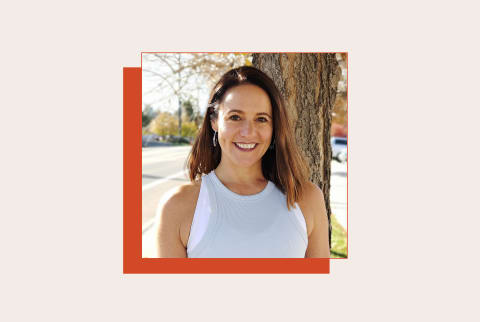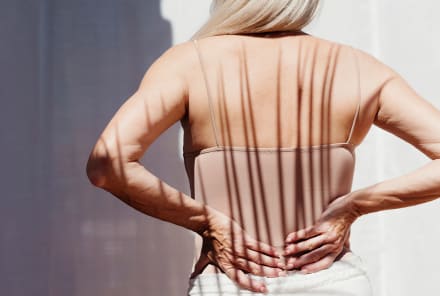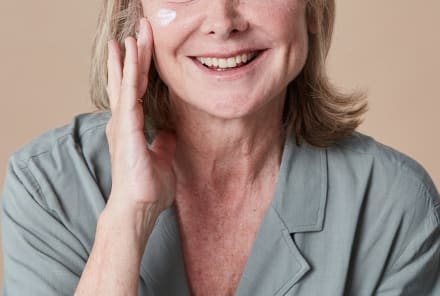Advertisement
5 Ways To Strengthen Your Feet & Why It’s Essential For Well-Being


We don't pay nearly enough attention to our foot health. When we do try to take care of our feet, we're bombarded with misinformation about everything from which shoes to buy to how we should walk. Clearing up this confusion is crucial because, without proper foot health, mobility in later life is out of the question.
Luckily, we have a comprehensive crash course on all things foot health in a recent episode of the mindbodygreen podcast. We sat down with foot and gait specialist and chiropractor Courtney Conley, D.C., to get the 101 on how to take better care of your feet and the role foot health plays in longevity, mobility, and overall health.
Here are five actionable takeaways from the episode. If you weren’t paying attention to your foot health before, consider this a great way to start.
Change your footwear
For so long, we’ve been told that more cushion is always better when it comes to shoes—but Conley disagrees. In fact, she generally recommends shoes that support your foot’s natural position. It’s more work for your feet—which is a good thing. The more work your feet have to do, the stronger they’ll get.
Her recommendations are plentiful, but each ideal shoe checks at least one of the two following boxes:
A wide toebox
"There's a very big difference between a wide shoe and a wide toe box," Conley says, so don’t be fooled by marketing. You want the toe of your shoe to be the widest point, just as your foot is naturally. Or, opt for barefoot style shoes with isolated toes.
Conley uses a metaphor to highlight this importance: Walking in narrow-toed shoes is like wrapping a rubber band around your foot and trying to hold a single-leg balance. "If you walked around with a sling on your arm for 20 years, you think your bicep would get weak?"
The same goes for limiting your toe splay—the less you allow your toes to move and strengthen, the weaker they will become.
Zero-drop
Instead of layering on the cushion for your shoes, take the opposite approach: Look for zero drop. However, be cautious, as many shoes labeled as "zero drop" aren’t truly zero drop, Conley says.
When searching for zero-drop shoes, evaluate the heel-to-toe drop measurement, which brands most often report in millimeters. The ideal range is anywhere from zero to six millimeters, Conley says, though many low-drop shoes fall around eight to twelve millimeters.
Side note: When to opt for high-cushion shoes
High-cushion shoes aren’t ideal for everyday wear, but Conley acknowledges they have their time and place. For example, when she’s walking around a metropolitan area like New York City, hitting the concrete for hours on end, she’ll opt for a higher-cushioned option to ease the blow.
However, even those shoes should have a wide toe box so your foot remains in its most natural position, preventing your toes from cramping up after a long day.
Walk barefoot
Like overall health, there’s a low-lift way to strengthen your feet: Walking–but walking barefoot is even better.
“We have over 200,000 sensory receptors on the bottoms of our feet that are screaming to feel things,” Conley says. When you walk barefoot, you’re stimulating all of these receptors on the bottom of the foot because you’re able to feel the ground and move your toes freely.
“I don't think there's anything much better than that,” she says about barefoot walking.
Do at-home foot-strengthening workouts
Strength training doesn’t have to stop at your feet—in fact, below the ankle holds plenty of opportunity for dedicated workouts. Below, three Conley mentions on the podcast:
- The credit card method: Sit in a chair and put a credit card under your big toe. Hold that card tight while someone tries to pull it out. "Your big toe should be able to hold that card down," Conley says, signaling toe strength. Then, do the same with your other four toes. If the card easily slips out or your foot cramps up, make this exercise a part of your weekly routine to build strength.
- The rubber band foot workout: Now, onto bicep curls—but for your toes. Place your foot on a rubber workout band that is the same width as your foot or wider. Pull the rest of the band up vertically, creating an L shape with your toes at the corner of the L. Then, try to pull your toes up against the resistance.
- The one with a rolled-up towel: Roll up a towel and place it underneath the tips of your toes while standing about 10 inches away from a wall. With your arms by your sides, lean into the wall and press your toes into the towel. Hold for five seconds, then relax. Repeat this a few times to complete the full-toe workout. This exercise strengthens your toes in a lengthened position, unlike the two drills above.
Use toe spacers
When it comes to affordable investments for foot health, toe spacers are a great place to start. For Conley, toe spacers helped her recover from years of foot strain caused by pointe ballet shoes.
Toe spacers align the toes and splay the foot out, stretching those toes in the opposite direction of how they’re typically positioned in cramped shoes.
This tool can even help relieve and prevent bunions—something many people assume is solely genetic. "You didn’t come out of the womb with a bunion," Conley says. You may have inherited connective tissue laxity or hyper-mobility, both of which increase your risk of bunions, but they can be prevented with attentive foot care.
In fact, Conley wears the toe spacers from her own brand, Gait Happens, most of the day: "I’m not kidding you, the only time they’re not on my foot is when I’m sleeping," she says.
Pay attention
Finally, Conley boils down her foot care advice to one general recommendation: Pay attention. Notice when your feet hurt, when shoes don’t fit properly, or when your toes cramp up. Even knee and joint pain can be traced back to changes in your foot health or shoe choice.
Do what you can, when you can, for the sake of healthier feet. If you can walk barefoot safely, do it. If you can afford a better-fitting pair of shoes, make the investment. If you have time for a five or ten-minute walk, take it. Something is better than nothing, especially if you’ve been neglecting foot health until now (don’t worry, we were too).
The takeaway
It’s time to take better care of your feet. By wearing the right shoes, strengthening your foot muscles, walking barefoot when you can, and utilizing additional foot health tools like toe spacers, you can make a huge difference in the feel and function of your feet. In the long run, you’ll be adding years to your mobility.
For more on foot health and injury prevention, tune into the latest episode. Listen on Apple Podcasts or watch on YouTube.
Watch Next
Enjoy some of our favorite clips from classes
Enjoy some of our favorite clips from classes
What Is Meditation?
Mindfulness/Spirituality | Light Watkins
Box Breathing
Mindfulness/Spirituality | Gwen Dittmar
What Breathwork Can Address
Mindfulness/Spirituality | Gwen Dittmar
The 8 Limbs of Yoga - What is Asana?
Yoga | Caley Alyssa
Two Standing Postures to Open Up Tight Hips
Yoga | Caley Alyssa
How Plants Can Optimize Athletic Performance
Nutrition | Rich Roll
What to Eat Before a Workout
Nutrition | Rich Roll
How Ayurveda Helps Us Navigate Modern Life
Nutrition | Sahara Rose
Messages About Love & Relationships
Love & Relationships | Esther Perel
Love Languages
Love & Relationships | Esther Perel
What Is Meditation?
Box Breathing
What Breathwork Can Address
The 8 Limbs of Yoga - What is Asana?
Two Standing Postures to Open Up Tight Hips
How Plants Can Optimize Athletic Performance
What to Eat Before a Workout
How Ayurveda Helps Us Navigate Modern Life
Messages About Love & Relationships
Love Languages
Advertisement

This Supplement May Remarkably Benefit Those With A High Risk Of Alzheimer’s
Molly Knudsen, M.S., RDN

Want To Be Metabolically Healthy? Study Shows An Underutilized Approach
Molly Knudsen, M.S., RDN

Don’t Eat A Lot Of Meat? Make Sure You Take This Supplement Daily
Molly Knudsen, M.S., RDN

Study Reveals 2 Habits That Are Early Signs Of Muscle Loss In Women
Molly Knudsen, M.S., RDN

This Supplement May Remarkably Benefit Those With A High Risk Of Alzheimer’s
Molly Knudsen, M.S., RDN

Want To Be Metabolically Healthy? Study Shows An Underutilized Approach
Molly Knudsen, M.S., RDN

Don’t Eat A Lot Of Meat? Make Sure You Take This Supplement Daily
Molly Knudsen, M.S., RDN

Study Reveals 2 Habits That Are Early Signs Of Muscle Loss In Women
Molly Knudsen, M.S., RDN

This Supplement May Remarkably Benefit Those With A High Risk Of Alzheimer’s
Molly Knudsen, M.S., RDN

Want To Be Metabolically Healthy? Study Shows An Underutilized Approach
Molly Knudsen, M.S., RDN

Don’t Eat A Lot Of Meat? Make Sure You Take This Supplement Daily
Molly Knudsen, M.S., RDN

Study Reveals 2 Habits That Are Early Signs Of Muscle Loss In Women
Molly Knudsen, M.S., RDN

This Supplement May Remarkably Benefit Those With A High Risk Of Alzheimer’s
Molly Knudsen, M.S., RDN

Want To Be Metabolically Healthy? Study Shows An Underutilized Approach
Molly Knudsen, M.S., RDN

Don’t Eat A Lot Of Meat? Make Sure You Take This Supplement Daily
Molly Knudsen, M.S., RDN

Study Reveals 2 Habits That Are Early Signs Of Muscle Loss In Women
Molly Knudsen, M.S., RDN










